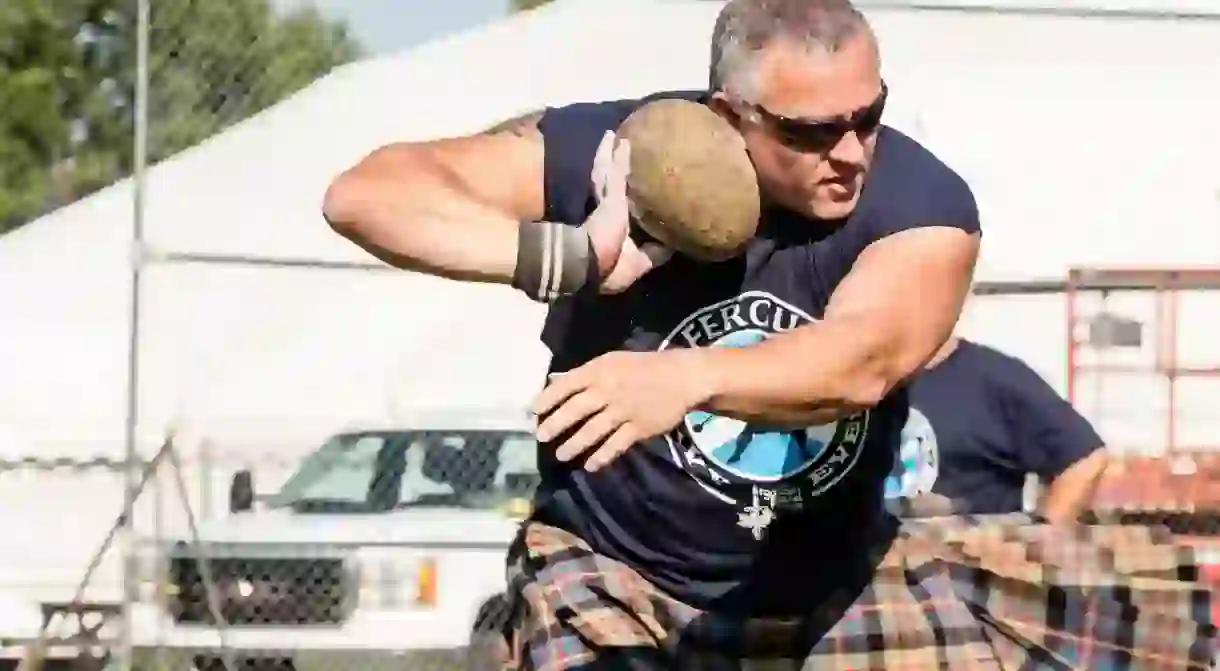What Events Are Played at the Highland Games?

Held across across Scotland during the summer months, the Highland Games are a huge celebration of the country’s culture. While music, dance and food play a big part, it’s the historic “heavy events” and their tests of strength that best symbolise the games. Here are the traditional events that you can expect to see.
Caber toss
Arguably the most famous of the heavy events and the image conjured up when people mention Highland Games, this sees competitors hold a huge tapered pole made of wood and try to throw, or toss, it as straight as possible. Cabers in Scotland are traditionally made from larch trees, measure 5.94m (19ft 6in) and can weigh 79kg (175lb). The distance that the caber is tossed is irrelevant – the aim is to toss it over its end so that it falls in a 12 o’clock position.
Scottish hammer throw
Very similar to the hammer throwing you see in the Olympics, this Scottish version sees competitors throw a metal ball as far as possible – but there are two key differences. Rather than a steel wire, the ball is attached to a firm wooden or plastic shaft; and while Olympians have a circle to turn in, Scottish hammer throwers must keep their feet fixed in one place. Throwers often wear specially designed shoes with metal blades at the front that dig into the ground to provide stability. Kiwi Valerie Adams, the Olympic and World Champion shot putter, also holds the women’s Scottish hammer record, launching it a fraction under 100ft.
Sheaf toss
A sheaf is a bundle of straw weighing 9kg (20lb) for men or 4.5kg (10lb) for women. The straw is wrapped in a bag made of burlap and competitors must use a pitch fork to throw it over a bar that gets progressively higher. Participants get three attempts to clear the bar, without the sheaf touching it, with those that manage to do so progressing to the next height. Slightly varying versions of sheaf tossing are played at events in Ireland, France, the Basque country and Australia. In 2010, Eric Frasure tossed the sheaf over a bar 11m (36ft 2in) tall.
Maide-leisg
A sort of one-on-one tug-of-war, the name comes from Scottish Gaelic and translates as “lazy stick”. This test of pure strength sees two competitors sit on the floor facing each other, with the soles of the feet placed against one another’s. Each person holds either end of the stick, whoever lifts their opponent off the ground wins.
Weight over the bar
Sometimes referred to as “weight for height”, this, like the sheaf toss, involves throwing over a raised bar. There are no bags or straw, however, with the object in question being a 25.4kg (56lb) weight with a handle at the end of a short bar. Competitors must throw the weight using just one hand and the raised bar gets higher with each successful attempt, gradually eliminating those competing. American Dan Williams broke the record in 2014 with a throw of 6.17m (20ft 3in).
You may like: The Best Highland Games in Scotland
Weight throw
One for those who prefer their weights hurled across a field rather than up in the air, this involves a weight being thrown as far as possible using one hand. There are two events: heavy (using a 25.4kg weight for men and a 12.7kg weight for women) and light (12.7kg for men and 6.35kg for women). Throwers can adopt any technique they choose, with most spinning to utilise the centrifugal force that creates. The best in the world throw the heavy weight around 15m (50ft).
Stone put
This event is split into two types: Braemar stone and Open stone. In both types the stone must be thrown from the toeboard, but the Open stone allows throwers to have a run up before launching. Because the stone can only be held in one hand, the event resembles the Olympic shot put, the Braemar stone type particularly so. Iconic British strongman Geoff Capes set a Braemar stone record of 17.37m (57ft).













